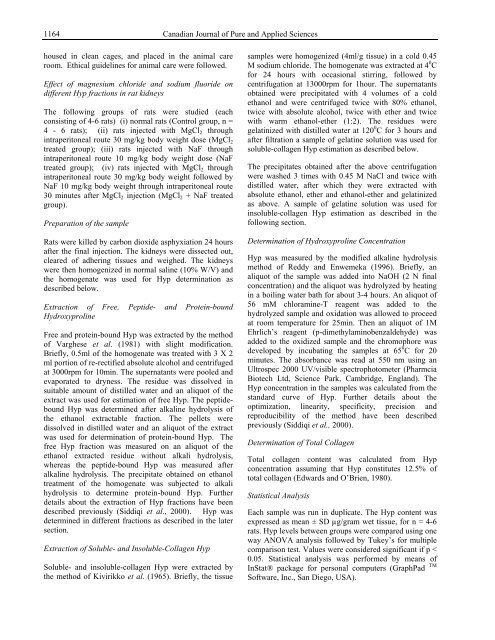Download (5Mb) - Covenant University Repository
Download (5Mb) - Covenant University Repository
Download (5Mb) - Covenant University Repository
Create successful ePaper yourself
Turn your PDF publications into a flip-book with our unique Google optimized e-Paper software.
1164<br />
housed in clean cages, and placed in the animal care<br />
room. Ethical guidelines for animal care were followed.<br />
Effect of magnesium chloride and sodium fluoride on<br />
different Hyp fractions in rat kidneys<br />
The following groups of rats were studied (each<br />
consisting of 4-6 rats) (i) normal rats (Control group, n =<br />
4 - 6 rats); (ii) rats injected with MgCl2 through<br />
intraperitoneal route 30 mg/kg body weight dose (MgCl2<br />
treated group); (iii) rats injected with NaF through<br />
intraperitoneal route 10 mg/kg body weight dose (NaF<br />
treated group); (iv) rats injected with MgCl2 through<br />
intraperitoneal route 30 mg/kg body weight followed by<br />
NaF 10 mg/kg body weight through intraperitoneal route<br />
30 minutes after MgCl2 injection (MgCl2 + NaF treated<br />
group).<br />
Preparation of the sample<br />
Rats were killed by carbon dioxide asphyxiation 24 hours<br />
after the final injection. The kidneys were dissected out,<br />
cleared of adhering tissues and weighed. The kidneys<br />
were then homogenized in normal saline (10% W/V) and<br />
the homogenate was used for Hyp determination as<br />
described below.<br />
Extraction of Free, Peptide- and Protein-bound<br />
Hydroxyproline<br />
Free and protein-bound Hyp was extracted by the method<br />
of Varghese et al. (1981) with slight modification.<br />
Briefly, 0.5ml of the homogenate was treated with 3 X 2<br />
ml portion of re-rectified absolute alcohol and centrifuged<br />
at 3000rpm for 10min. The supernatants were pooled and<br />
evaporated to dryness. The residue was dissolved in<br />
suitable amount of distilled water and an aliquot of the<br />
extract was used for estimation of free Hyp. The peptidebound<br />
Hyp was determined after alkaline hydrolysis of<br />
the ethanol extractable fraction. The pellets were<br />
dissolved in distilled water and an aliquot of the extract<br />
was used for determination of protein-bound Hyp. The<br />
free Hyp fraction was measured on an aliquot of the<br />
ethanol extracted residue without alkali hydrolysis,<br />
whereas the peptide-bound Hyp was measured after<br />
alkaline hydrolysis. The precipitate obtained on ethanol<br />
treatment of the homogenate was subjected to alkali<br />
hydrolysis to determine protein-bound Hyp. Further<br />
details about the extraction of Hyp fractions have been<br />
described previously (Siddiqi et al., 2000). Hyp was<br />
determined in different fractions as described in the later<br />
section.<br />
Extraction of Soluble- and Insoluble-Collagen Hyp<br />
Soluble- and insoluble-collagen Hyp were extracted by<br />
the method of Kivirikko et al. (1965). Briefly, the tissue<br />
Canadian Journal of Pure and Applied Sciences<br />
samples were homogenized (4ml/g tissue) in a cold 0.45<br />
M sodium chloride. The homogenate was extracted at 4 0 C<br />
for 24 hours with occasional stirring, followed by<br />
centrifugation at 13000rpm for 1hour. The supernatants<br />
obtained were precipitated with 4 volumes of a cold<br />
ethanol and were centrifuged twice with 80% ethanol,<br />
twice with absolute alcohol, twice with ether and twice<br />
with warm ethanol-ether (1:2). The residues were<br />
gelatinized with distilled water at 120 0 C for 3 hours and<br />
after filtration a sample of gelatine solution was used for<br />
soluble-collagen Hyp estimation as described below.<br />
The precipitates obtained after the above centrifugation<br />
were washed 3 times with 0.45 M NaCl and twice with<br />
distilled water, after which they were extracted with<br />
absolute ethanol, ether and ethanol-ether and gelatinized<br />
as above. A sample of gelatine solution was used for<br />
insoluble-collagen Hyp estimation as described in the<br />
following section.<br />
Determination of Hydroxyproline Concentration<br />
Hyp was measured by the modified alkaline hydrolysis<br />
method of Reddy and Enwemeka (1996). Briefly, an<br />
aliquot of the sample was added into NaOH (2 N final<br />
concentration) and the aliquot was hydrolyzed by heating<br />
in a boiling water bath for about 3-4 hours. An aliquot of<br />
56 mM chloramine-T reagent was added to the<br />
hydrolyzed sample and oxidation was allowed to proceed<br />
at room temperature for 25min. Then an aliquot of 1M<br />
Ehrlich’s reagent (p-dimethylaminobenzaldehyde) was<br />
added to the oxidized sample and the chromophore was<br />
developed by incubating the samples at 65 0 C for 20<br />
minutes. The absorbance was read at 550 nm using an<br />
Ultrospec 2000 UV/visible spectrophotometer (Pharmcia<br />
Biotech Ltd, Science Park, Cambridge, England). The<br />
Hyp concentration in the samples was calculated from the<br />
standard curve of Hyp. Further details about the<br />
optimization, linearity, specificity, precision and<br />
reproducibility of the method have been described<br />
previously (Siddiqi et al., 2000).<br />
Determination of Total Collagen<br />
Total collagen content was calculated from Hyp<br />
concentration assuming that Hyp constitutes 12.5% of<br />
total collagen (Edwards and O’Brien, 1980).<br />
Statistical Analysis<br />
Each sample was run in duplicate. The Hyp content was<br />
expressed as mean ± SD µg/gram wet tissue, for n = 4-6<br />
rats. Hyp levels between groups were compared using one<br />
way ANOVA analysis followed by Tukey’s for multiple<br />
comparison test. Values were considered significant if p <<br />
0.05. Statistical analysis was performed by means of<br />
InStat® package for personal computers (GraphPad TM<br />
Software, Inc., San Diego, USA).

















